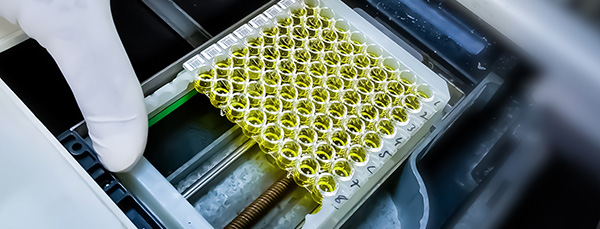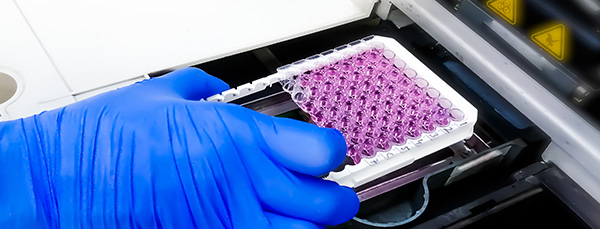
Enzyme-linked immunosorbent assay (ELISA) remains one of the most popular immunoassay techniques due to its ease of use, high sensitivity, and ability to provide quantitative results. It can be configured in several different ways – direct, indirect, sandwich, and competitive ELISA – of which the sandwich ELISA format is most commonly used. Whether you are developing an ELISA in-house or using an off-the-shelf kit, there are steps you can take to ensure that experimental data are accurate and reproducible. Here are our top ten tips.

- Handle samples with care
The types of samples analyzed by ELISA include cell lysates, tissue homogenates, and culture supernatants, as well as bodily fluids such as serum, urine, and saliva. Often, these will need to be diluted prior to use to reduce matrix effects or bring the analyte concentration into the detectable range of the assay. When diluting samples, it is recommended to use an intermediate plate that also contains relevant standards and controls. This will help to avoid delays upon transfer into the assay plate, which could skew the data. Other suggested best practices include avoiding freeze-thawing samples and being consistent with the methods used for sample collection and processing.
- Bring all reagents to room temperature before use
When running an ELISA, it is important to bring all of the reagents up to room temperature prior to use unless the protocol specifically states not to. This will help to ensure that the binding kinetics are consistent between assays, as well as keep temperature-sensitive components in solution. If the ELISA is configured to produce a chromogenic readout, such as through pairing a horseradish peroxidase (HRP) labeled antibody with 3,3′,5,5′-tetramethylbenzidine (TMB) for detection, both the substrate and the stop solution should likewise be brought to room temperature for stable color development.
- Use a multichannel pipet for dispensing samples and reagents
Using a multichannel pipet for dispensing samples and reagents will help to improve experimental consistency by reducing any variability in incubation times across the plate. To confirm that an equal volume of liquid is being drawn into and dispensed from each tip, researchers should visually inspect the multichannel pipet during use. Multichannel pipets should be calibrated regularly to safeguard their accurate performance, and it is advised to use the same pipet when repeating an ELISA, as this will help eliminate a potential source of variation between experiments.
- Practice proper pipetting technique
Proper pipetting technique is fundamental to generating reproducible results. Best practice recommendations include selecting an appropriate pipet for the volume to be added (e.g., do not use a 200-1000 µL pipette to dispense volumes below 200 µL), dispensing liquids with the pipet tips held at an angle and not touching the bottom of the wells, and always changing the pipet tips between different samples or standards to avoid cross-contamination.
- Use a plate washer
Insufficient washing can cause high background, leading to reduced assay sensitivity. Researchers are advised to use a plate washer instead of performing manual washes as this will supply greater force when dispensing liquid into the wells to better reduce non-specific binding. It is also recommended to include a 30-second soak in between washes to ensure the wash buffer has time to act. After the final wash, any residual buffer should be removed by inverting the plate and blotting it against clean paper towels, but it is important that the plate is not allowed to dry out prior to adding the next assay reagent.
- Perform optimization
If you are using an off-the-shelf ELISA kit, very little will be required in terms of optimization besides ensuring that the analyte concentration of your samples falls within the limits of detection of the assay. However, if you are developing an ELISA in-house, factors to optimize include everything from plate coating, blocking, and washing, through to the method used for detection. When developing a sandwich ELISA, selecting matched antibody pairs is critical. This means using capture and detection antibodies that each recognize a different epitope on the analyte to avoid competition for target binding. It is also essential to choose secondary antibodies that have been cross-adsorbed if the ELISA will use indirect detection. Non-specific binding of secondary antibodies to the antibody used for target capture could otherwise be mistakenly identified as a positive result.
- Stick to the protocol
For reproducible results, it is vital to stick to the protocol whether provided by the kit, or your own in-house method. This includes being consistent with how samples are prepared, always using the optimized assay conditions, and adhering to incubation times and temperatures. As a general rule, it is suggested that timings do not vary by more than +/- 5 minutes per hour of incubation. Introducing automation into ELISA workflows can help minimize potential sources of variation.
- Never skimp on controls and reference standards
Controls are used for data analysis and verifying assay performance. They typically consist of known positive and negative samples, such as lysates from stimulated versus untreated cells or homogenates from diseased versus healthy tissue samples. Reference standards are used for constructing a sigmoidal curve against which the concentrations of test samples can be calculated. Controls and reference standards should be included on every assay plate, and it is recommended that controls be positioned in such a way as to highlight any plate drift (e.g., columns 1 and 12 of a 96-well plate are often used as control wells, with the positive control being in wells A1-D1 and E12-H12, and the negative control in wells E1-H1 and A12-D12).
- Always perform comparative testing if lot numbers change
To avoid data variation over time due to a different batch of reagent being used, or a new kit lot becoming available, it is essential to perform comparative testing every time such a change occurs. This is easily achieved by running positive and negative control samples along with a reference standard to confirm that similar results are seen in each case.
- Don’t be scared to ask for help!
Whatever type of ELISA you choose to perform, never be scared to ask for help. Jackson ImmunoResearch has a wealth of experience when it comes to ELISA and can provide guidance for selecting the right antibodies, blocking agents, control proteins, and more to best support your research.
| Learn more: | Do more: |
|---|---|
| Indirect and direct Western blotting | Exhibition Schedule |
| Chemiluminescence western blotting | Cite and Win |
| An Introduction to Expansion Microscopy | Past Competition Winners |



